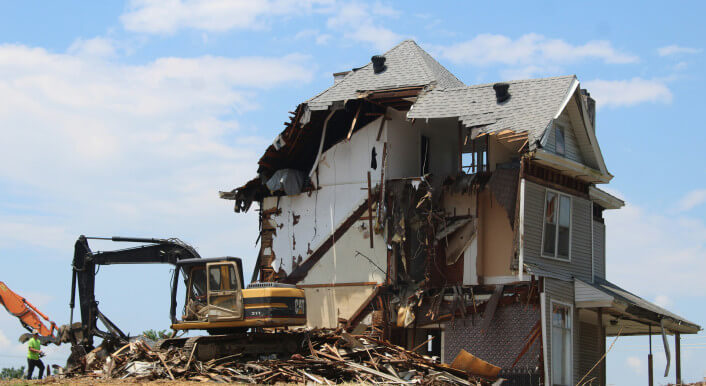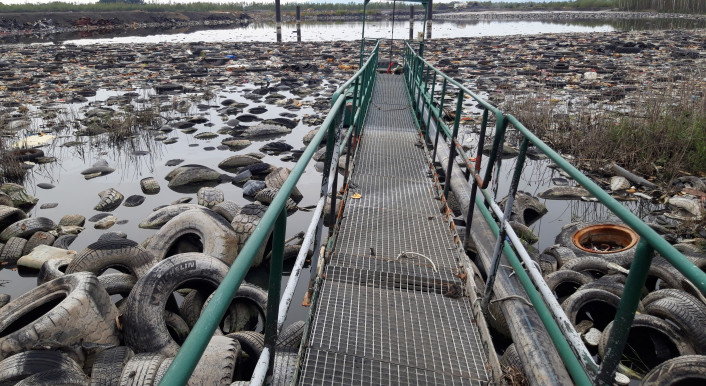„White Gold“: Debris and Deception
Crooked deals with waste are just as lucrative to drug deals – only easier to conceal. An investigation by CORRECTIV.Europe shows how two companies from Germany and Czechia are making hundreds of thousands of tonnes of debris disappear just behind the border.

At the end of this investigation involving thousands of tonnes of white substance being delivered across the German-Czech border for years, we contact one of the dealers. We pretend to be interested in doing business together. Petr D. – who has long been in the sights of Czech authorities – takes the bait. After a few minutes, he asks: “Are you looking for a cheap solution?” D., who speaks German, says he often travels to Germany on business. He apparently has a “partner” in Bavaria who acts as broker to get the goods across the border. “We take it from company M., that’s our main supplier.”
This is not a story about cocaine, but gypsum. More precisely: gypsum waste and other debris from constructions and demolitions.
According to Europol, crooked waste deals are just as lucrative to the organised drug trade. The EU Commission estimates that criminal activity in connection with illegal waste disposal in Europe creates yearly profit of up to 15 billion euros.
“Utilised” in Germany, illegally disposed of in a neighbouring country?
Nothing generates as much waste as construction sites and building demolitions. Recent figures from the German Federal Environment Agency (Umweltbundesamt – UBA) indicate that a total of more than 200 million tonnes of such waste was generated in Germany – more than half of the country’s total annual waste volume.
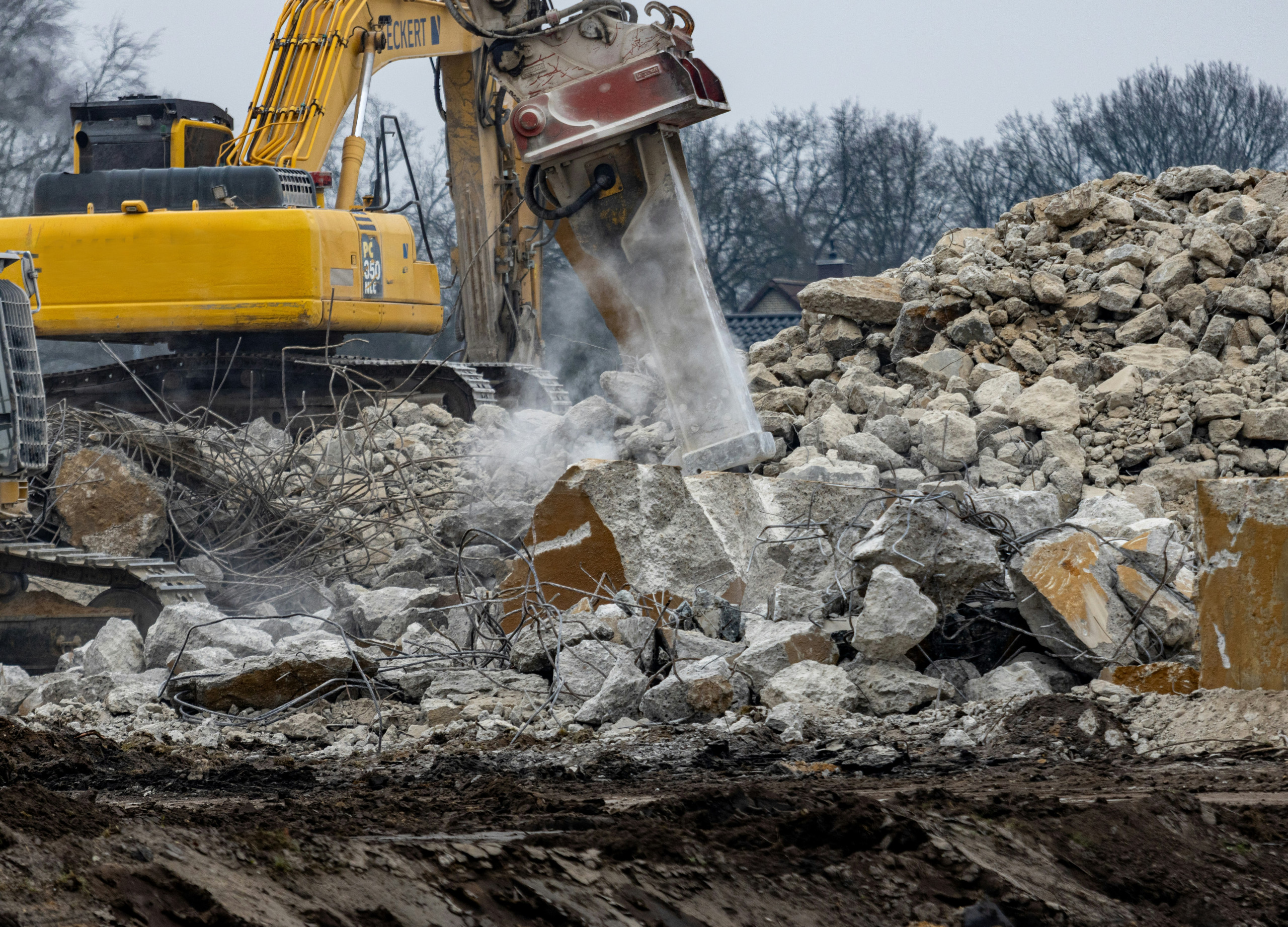
According to the German Waste Management and Product Recycling Act (Kreislaufwirtschaftsgesetz – KrWG), waste must be utilised to the highest quality possible, ideally recycled. This already works excellently for a lot of construction waste – at least, this is what the construction industry and the waste management sector claim. But the official figures are ridden with inconsistencies. Is waste that is officially deemed utilised in Germany actually being disposed of illegally in neighbouring countries?
Loopholes in waste legislation
This investigation by CORRECTIV.Europe indicates that waste dealers have apparently been dumping debris from Germany in the Czech Republic on a large scale for years. It seems they are knowingly exploiting the in some cases contradictory legislation in Europe. In this grey area, it is not always clear who is the perpetrator and who the victim. Even the responsible authorities therefore find it difficult in some cases, despite clear indications, to identify those responsible and enforce the applicable law. But while authorities in the Czech Republic have been observing one of the suspects behind the dubious waste business for years, the German authorities appear to be clueless.
The damage affects not only the environment. While some players are profiting from crooked waste deals, companies that actually utilise waste legally are losing out. One German waste dealer, who wishes to remain anonymous, told CORRECTIV.Europe: “This cheap disposal is destroying business for honest companies and for the recycling industry in Germany.”

“Gypsum plays a decisive role in our future construction”
This dubious disposal is particularly paradoxical in the case of gypsum. This mostly whitish, shimmering, sulphate-class mineral can be found in almost every house: primarily in plasterboard, which is used to build walls and ceilings in lightweight construction, but also as an additive in plaster, mortar, screed and adhesives, in aerated concrete blocks or in decorative stucco on ceilings. According to a 2020 report commissioned by the German Conference of Environment Ministers (Umweltministerkonferenz), gypsum “plays a decisive role in our future construction”.
At around 640,000 tonnes, gypsum waste only accounts for a fraction of the debris produced each year. Compared to most mineral waste, however, gypsum waste is considered particularly problematic. Mixing gypsum with organic substances can produce hydrogen sulphide – a gas which, as the German Federal Environment Agency warns, “leads to odour nuisance in low concentrations, but is lethal in high concentrations”. Moreover, the sulphates contained in gypsum can be washed out and pollute groundwater.
To discover the tricks used by waste dealers to make the material disappear in the Czech Republic, we made numerous enquiries to authorities in Germany and the Czech Republic. We also tracked down questionable waste transports online on a transport platform and analysed satellite images. Finally, we went undercover and initiated contact with some of the individuals suspected of being involved in this dirty business.
The waste dealers’ tricky system
A picture gradually emerged of two companies between which construction waste from Germany has been moving for years: the export company M., based in Bavaria, and on the other side of the border, the company of Czech waste dealer Petr D., who Czech authorities have had on their radar for a long time due to suspected illegal waste disposal activities.
In response to an enquiry from CORRECTIV.Europe, the Czech Environmental Inspectorate confirmed it has files on both companies.
The companies apparently have a system: Bavarian company M. acquires waste from throughout Germany, which waste dealer Petr D. imports into the Czech Republic via one of his companies and subsequently sells it on to various recipients – until it is no longer evident that the waste comes from Germany and should not be disposed of in the Czech Republic. Both companies are apparently involved in an intricate network that Czech authorities are still trying to unravel.
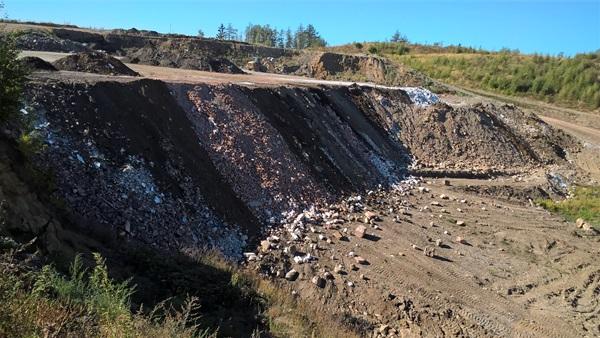
The Czech authorities had received initial indications of the dirty dealings back in 2019, when the Environmental Inspectorate announced in a report what its inspectors had found in a quarry just over the border: The operating company had allegedly dumped mostly “untreated building waste and demolition waste” in the pit, including over 6000 tonnes of gypsum waste and almost 9000 tonnes of a mix of concrete, bricks, roof tiles and ceramic waste.
The discovery in the pit was just the beginning, however. Around a year and a half after the investigation of the quarry, inspectors from the Czech Environmental Inspectorate discovered where all this debris had apparently originated: Waste dealer Petr D. allegedly imported the waste from Germany and “continually” passed it on over years to the operator of the quarry. The waste imported from Germany polluted the environment as it was “illegally disposed of” rather than correctly utilised, explained the Czech Environmental Inspectorate in response to an enquiry from CORRECTIV.Europe.
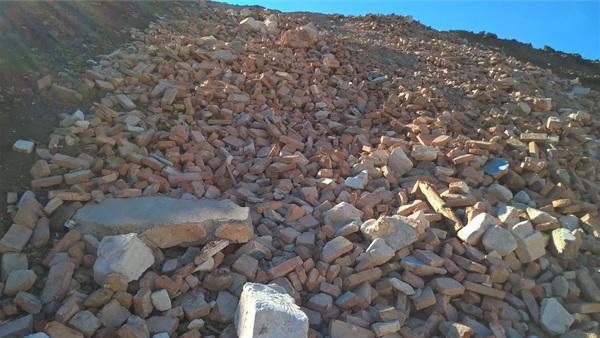
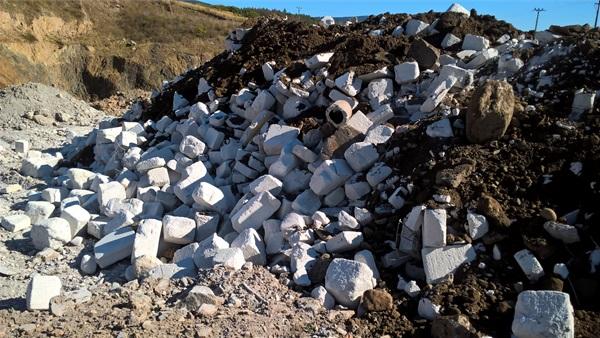
The scale of this dirty business was apparently far greater than authorities had initially realised, however: Between 2017 and 2020 alone, waste dealer Petr D. is alleged to have imported 20,000 tonnes of “unprocessed slag” as well as massive amounts of building waste, including over 30,000 tonnes of concrete and bricks. By far the largest proportion of waste, however, was attributable to “gypsum-based building materials”: Petr D. is alleged to have imported over 125,000 tonnes of gypsum waste from Germany during this period.
A white layer covers the former quarry where, according to the Czech Environmental Inspectorate, masses of debris from Germany have been illegally dumped – including around 120,000 tonnes of gypsum waste between 2017 and 2020 alone. Credits: Google Earth Pro / Google Earth Engine timelapse
Undeterred despite fines
The authorities also discovered something else when inspecting the seized transport documents: the identity of the party from whom Petr D. had received these masses of waste from Germany. In response to enquiries from CORRECTIV.Europe, the authorities divulged that Petr D.’s import company had received all the debris – “almost 200,000 tonnes in total” – from a single source: Bavarian-based company M.
The Czech Environmental Inspectorate imposed fines of around 5,000 euros on the company alleged to have dumped the waste in its quarry and around 11,000 euros on Petr D.’s company, which is alleged to have imported the waste into the Czech Republic. By contrast, company M. from Bavaria – which allegedly brokered all the waste that was transported from Germany to the Czech Republic – has to this day avoided any retribution, according to our research.
Dubious waste exports “organised” by Bavarian company
The Czech Ministry of the Environment states that “the cross-border transport of waste for disposal in the Czech Republic is prohibited”. Apparently, “the responsible authorities in Germany have been informed of this repeatedly”. In the case of the quarry just over the border, according to the Czech Environmental Inspectorate, it may have been “merely a case of faking correct utilisation” of the waste, which was then “actually disposed of by backfilling (depositing) in the quarry”.
However, the Bavarian company alleged to have acquired all the waste from Germany seems not to have been dissuaded from its export activities. Just last year, according to the Czech Environmental Inspectorate, the Bavarian company “organised” further waste transports to Petr D.’s company – and this waste has apparently also ended up in the quarry.
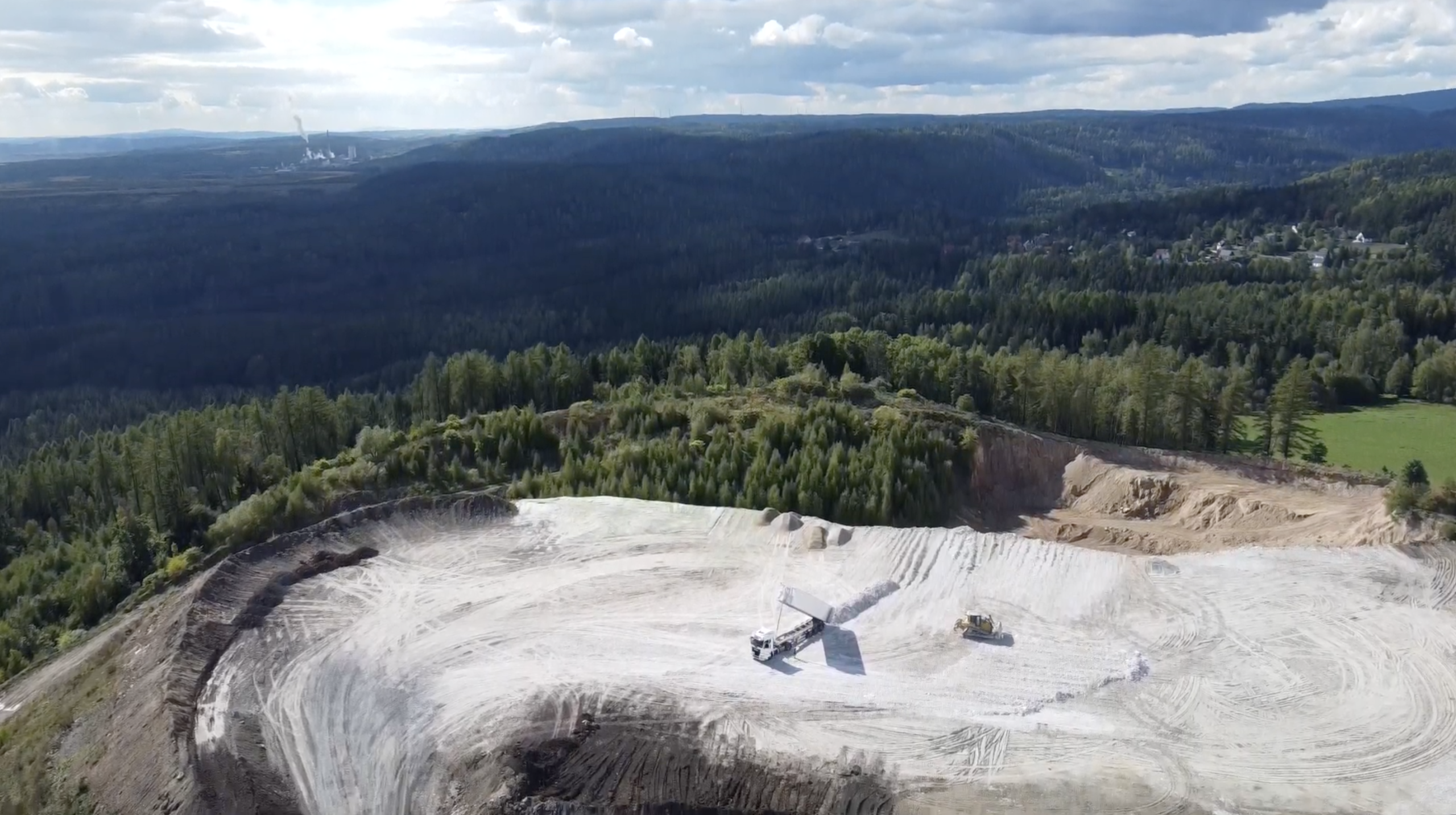
During an inspection, Czech authorities were at least able to stop a truck from Germany before it could unload its dirty cargo: the gypsum waste was mixed in with polystyrene, metal and insulation residues. According to Czech authorities, this waste should have been declared as “mixed building and demolition waste”, and the export should have been authorised beforehand.
Transports continue today
On a freight exchange platform on the internet, we discover numerous dubious waste exports currently being organised for transport to the Czech Republic. Haulage companies advertise transport orders on this exchange, entering where cargo is to be picked up and where it is to be unloaded. Between the end of October and mid-November alone, we documented over fifty such advertisements on the transport exchange for loads to be collected from various locations – mainly in southern Germany. These loads are mostly labelled as “plasterboard / building demolition waste”, or simply as “gypsum”. Some transport orders specify “slag” as the cargo load – a waste product that can be used as a building material but is often contaminated with toxic heavy metals.
To find out exactly where the waste comes from and to whom it is being delivered, we pretend to be a freight forwarder from Germany. Undercover, we call the Czech haulage company that has advertised all the shipments. We express our interest in a load of gypsum waste which, according to the advertisement, is to be collected in Nuremberg. The haulage company employee gives us the exact address: a mega construction site on the outskirts of Nuremberg.
The site used to feature a huge building complex that housed mail-order giant Quelle. A group of property investors intends to transform the partly heritage-protected site into a residential and commercial quarter dubbed “The Q”. This undertaking is considered one of the largest conversion projects in Europe. Following the bankruptcy of the main investor, construction cranes temporarily came to a standstill. However, renovation and construction work has been underway again since the end of 2023 – apparently also generating gypsum waste. We would have liked to have found out from the builders who was responsible for disposing of the waste but our enquiry went unanswered.

Credits: Florian Peljak / picture alliance / SZ Photo
By contrast, the employee of the Czech haulage company advertising the waste transports on the freight exchange speaks candidly. When we call her undercover, we ask explicitly whether all the waste transports from Germany are organised by company M. “Yes, exactly,” confirms the haulage company employee. And is it the company of Petr D., the Czech waste dealer, importing the waste? Again, a clear answer: “Exactly, yes.”
Why do undercover investigations?
According to the German Press Council, undercover investigations are permissible “if used to obtain information of particular public interest that is not accessible in any other way”. In our opinion, the alleged illegal disposal of large volumes of waste and the associated potential environmental hazards justify such undercover investigations. We have therefore conducted undercover investigations – as prescribed by the Press Council – in justified individual cases where information could not be expected in response to regular press enquiries. We have transcribed verbatim the wording of these undercover interviews.
The woman on the phone also tells us the exact destination where all the waste from Germany is to be dumped: the premises of a small Czech company. Hidden from view in a wooded area by a tributary to the Elbe, this company is also backfilling an old quarry just over the border.
“Backfilling pits is a popular method of illegal waste disposal”
Satellite images from September 2025 show part of the quarry covered by a white layer, atop which are several trucks. It appears that large volumes of gypsum waste and possibly other debris were also recently dumped in this pit.
Anyone delivering gypsum waste to this pit pays the equivalent of around fifty euros per tonne. This price, which was retrieved from a price list published by the company on its website, is significantly cheaper than in Germany. For comparison: At a landfill site for debris in the greater Munich area – from where, according to our research on the transport exchange, a particularly large amount of waste is apparently currently being delivered to the quarry – the disposal of gypsum waste costs 90 euros per tonne. In other parts of Germany, landfill disposal can be even more expensive (see info box).
Landfill shortage: “Especially the construction industry fears a crisis”
The German Gypsum Industry Association (Bundesverband der Gipsindustrie) has long opposed the landfilling of recyclable gypsum waste. Nevertheless, around 40 percent of gypsum waste in Germany continues to end up in landfills. Prices for landfilling gypsum waste vary considerably by region: from 85 euros per tonne at a landfill site in the Rhineland, to 130 euros in Thuringia, 156 euros in southern Lower Saxony, around 180 euros in some regions of Bavaria and up to 209 euros at a landfill site in Baden-Württemberg.
Gypsum waste may only be stored at landfills under very specific conditions and must be separated from other waste. Despite this, the material “regularly causes problems” at these landfills, according to a report by the Federal/State Waste Committee (Bund/Länder-Arbeitsgemeinschaft Abfall – LAGA). Contact with concrete can cause “damage to the components”. In addition, gypsum waste is apparently “unfavourable for the stability of the landfill composition”. This is also one of the reasons gypsum boards may no longer be landfilled in Austria from 2026.
If gypsum waste mixes with other debris on construction sites, even this other waste “can only be reused to a very limited extent due to the sulphate content of the gypsum”, according to the Berlin Senate Department. “Building waste that is contaminated with gypsum is therefore not accepted by disposal companies at all or only at significantly higher disposal prices.”
At any rate, landfill capacities in many regions of Germany are becoming increasingly scarce. According to the German Federal Statistical Office, almost half of the thousand or so landfill sites in Germany will be at full capacity by 2032. “Especially the construction industry fears a crisis,” reported the Zeitung für kommunale Wirtschaft (ZfK) in August 2024.
That there has been a “shortage for years” in landfilling of building waste is also confirmed by Andreas Pocha, Managing Director of the German Demolition Association (Deutscher Abbruchverband – DA). “The situation is particularly tense in federal states with a high level of construction activity and limited landfill capacities, such as Bavaria and Hesse”. According to our research, it is precisely from these federal states that conspicuously large volumes of gypsum waste are disappearing to the Czech Republic.
In response to an enquiry from CORRECTIV.Europe, the Czech Environmental Inspectorate confirmed it is aware of the ongoing gypsum waste transports and that these are currently being investigated.
“Backfilling pits is a popular method of illegal waste disposal,” says expert Berend Wilkens. In some cases, backfilling pits with waste can be even more lucrative than mining the raw materials themselves. Most recently, Wilkens managed Europe’s largest hazardous waste landfill site near Rostock; prior to this he was managing director of another hazardous waste company, SBB Sonderabfallgesellschaft Brandenburg/Berlin mbH, for 27 years. In his altogether forty years of professional experience, Wilkens has inspected many waste exports – both on paper and during actual transport inspections on the road.
“Dubious waste brokers offering fake waste utilisation at dumping prices”
The German Federal Environment Agency (UBA) also warned of this scenario in a report back in 2017: “A decisive factor” in advancing gypsum recycling in Germany would be “the prevention of inexpensive and fake waste utilisation through technically and ecologically dubious channels.”
In order to “prevent such ecologically harmful practices”, the UBA recommended better communication between the respective enforcement authorities of the federal states. The authorities should “tip each other off” – especially when it comes to “dubious waste brokers offering fake waste utilisation at dumping prices”.
Clean hands despite dirty deals?
Brokers act as intermediaries in the waste industry, meaning they only deal with waste generated by other companies and generally do not dirty their own hands. The broker company M. is domiciled in a municipality in Lower Franconia. Its premises, nestled on the outskirts of a prefabricated housing estate, is a brilliant white house featuring a large garden, pond and terrace. How much waste has the company brokered to the Czech Republic over the years? More importantly, does the company know that its business partner in the Czech Republic illegally disposes of at least some of the waste?
We would have liked to have received answers to these and many other questions directly from the responsible persons at company M. Unfortunately, we received no response from management to our extensive catalogue of questions. In fact, the very day we sent our questions, the company’s website went offline. Shortly thereafter we received a letter from a law firm asking us not to report on company M. The main reason provided by the law firm was that questions asked by CORRECTIV lacked specificity. However, this is not true: we sent a catalogue of questions including ten very specific questions, some also with further sub-questions. For example, we asked about individual deliveries to clearly named recipient companies.
Are the papers being manipulated?
So instead, we contacted the Czech company suspected of backfilling its quarry with waste received from Petr D. This time, we identify ourselves as journalists from Germany. When we ask what his company does with the waste from Germany, we receive a surprising answer from the manager of the quarry by email: “We do not receive (and therefore do not process) any waste from abroad. The materials are contractually supplied to us exclusively from the Czech Republic.”
Is the company truly unaware that the waste it is dumping in its quarry originates from Germany? If so, at what point does the waste trail go cold?
Dubious stopover
According to the advertisements on the freight exchange, which we documented over recent weeks, the trucks are supposed to make a stopover on their way from Germany to the Czech Republic: in an industrial area of the town of Svatava. More specifically – at the premises of the company belonging to waste dealer Petr D. All they do there is “confirm the papers”, the haulage company employee tells us on the phone, “then we continue on our way.”
This raises a question: Could it be that the papers are not “confirmed” during the stopover but instead manipulated to conceal the origin of the waste?
Upon enquiry, the Czech Environmental Inspectorate revealed to us that this question is the subject of their current investigations. However, waste dealer Petr D. has apparently already engaged in trickery in the past. He is alleged to have passed on waste that his company received from Bavarian company M. to recipients in the Czech Republic “without processing”, “thereby concealing its origin”. The authorities suspect that the disposal of the gypsum waste may also have been “merely a fake utilisation of this waste”. Instead, it may be that the waste was “actually disposed of by backfilling the quarry”.
“If a recipient isn’t aware they are accepting waste from abroad, it’s evident that the papers relating to the waste must have been manipulated along the way,” says expert Berend Wilkens, who we asked to evaluate the findings of our research. “German waste is obviously being turned into Czech waste on paper. It can’t really be explained otherwise.”
Undercover call to the waste dealer
Time for a call to Petr D. himself. We pretend to be a waste dealer from Germany. We tell him we had heard that he was disposing of gypsum waste. D. is initially monosyllabic in his responses: “Yes, right”. When probed, he tells us more: “We offer that as well as transport. We take care of it all. A Czech haulage company collects it from the customer”. He apparently also takes other debris, especially asphalt and concrete. We want to know what happens to the gypsum waste once it arrives in the Czech Republic. Petr D. is evasive. Instead, he asks: “Are you looking for a cheap solution?”
He does not want to name specific prices right off the bat. We ask what his “cheap solution” might look like and tell him we want to know whether his company recycles the waste or passes it on to other customers in the Czech Republic. “We pass it on,” he replies, claiming that his company strives for “material utilisation of building materials”.
“We recycle it”, claims the waste dealer
We probe again: “Material utilisation – so that would also involve recycling gypsum in the Czech Republic?” Petr D. responds: “Yes, we recycle it”. Petr D. obviously knows the technical processes involved in recycling gypsum waste: he even tells us about the gypsum waste recycling plants in Germany. What he fails to mention is that such recycling is a highly technical process; there are only a few plants in Europe capable of this, and not a single one in the Czech Republic.
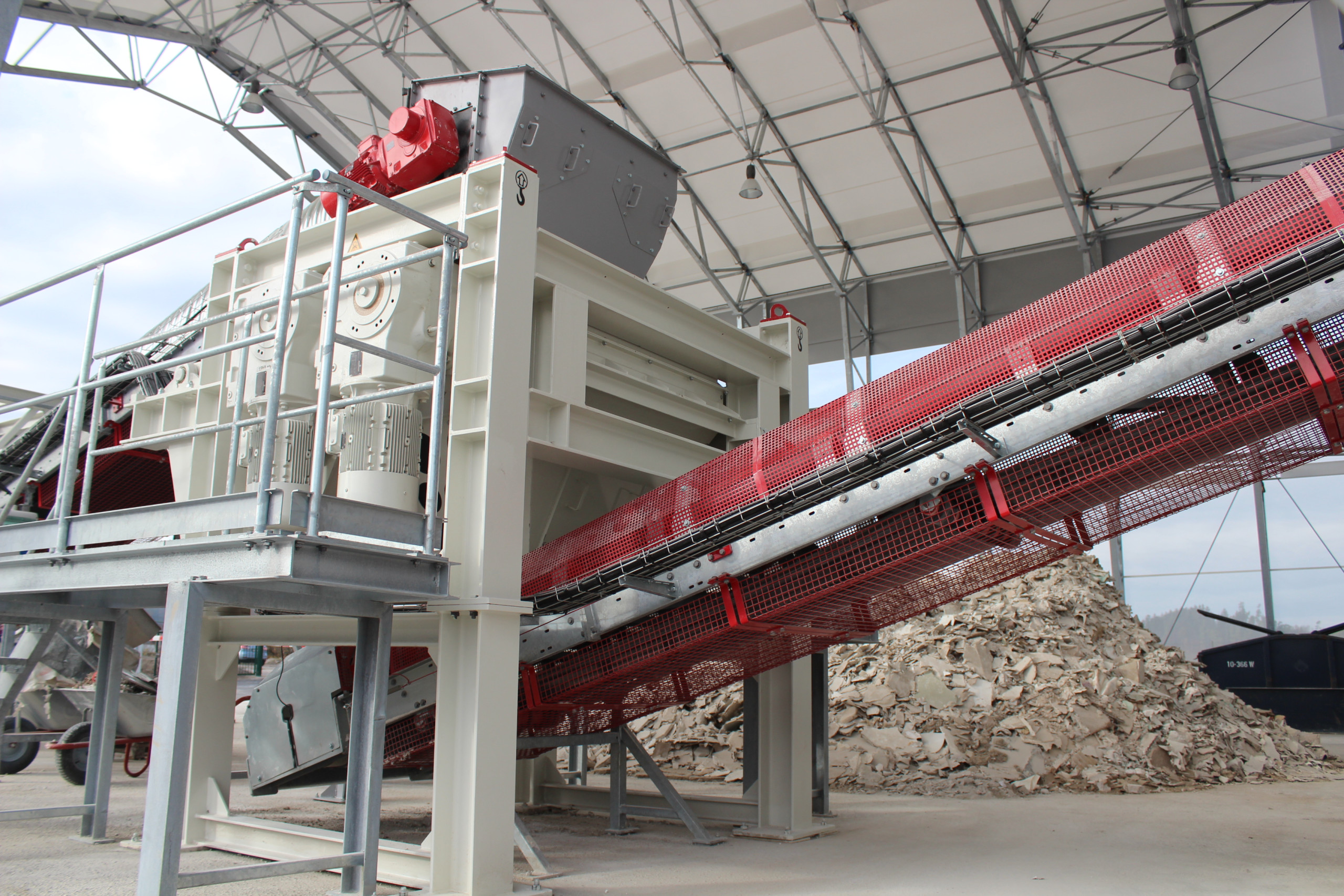
We ask whether gypsum waste can be used in the Czech Republic to backfill old pits, for so-called recultivation. His answer surprises us: “Recultivation with gypsum is no longer possible.”
Our question: “No longer possible?”
Petr D.: “It’s no longer possible, no.”
Question: “So only material utilisation is possible?”
Petr D.: “Yes, yes, material utilisation, yes.”
It is an obvious contradiction: Petr D. confirms on the phone that gypsum waste can no longer be dumped in the Czech Republic for use in recultivation – but according to our research, this is presumably precisely what happens with the waste that his company imports from Germany. We would have liked Petr D. to explain this contradiction to us himself. However, we received no response to our press enquiry, which we sent him in writing after the call. Petr D. subsequently disappears.
Bridges blown up, swimming pools demolished – customers include multi-million-euro companies
The Czech Environmental Inspectorate instead gives us the names of twenty German companies alleged to have been customers of broker company M. These include small recycling centres, container services and collection points where construction companies and private individuals can deliver debris. But there are also companies which generate turnover in the millions and carry out major contracts throughout Germany – such as demolitions of bridges or swimming pools.
A German businessman, who wishes to remain anonymous, tells CORRECTIV.Europe that the dirty dealings with gypsum waste have long been known in the industry. Petr D., the Czech waste dealer, is apparently “the man for gypsum” in the Czech Republic. D. has allegedly been handling the business together with Bavarian company M. for years. This collaboration apparently makes company M. “the biggest fish in our industry when it comes to gypsum disposal”.
The insider explains that he also used to have gypsum waste exported to the Czech Republic via these two companies. In retrospect, he takes a critical view: “We’re mining gypsum here, damaging our environment, and at the same time we’re dumping it into a hole over there – even though we have recycling plants for gypsum in Germany.”
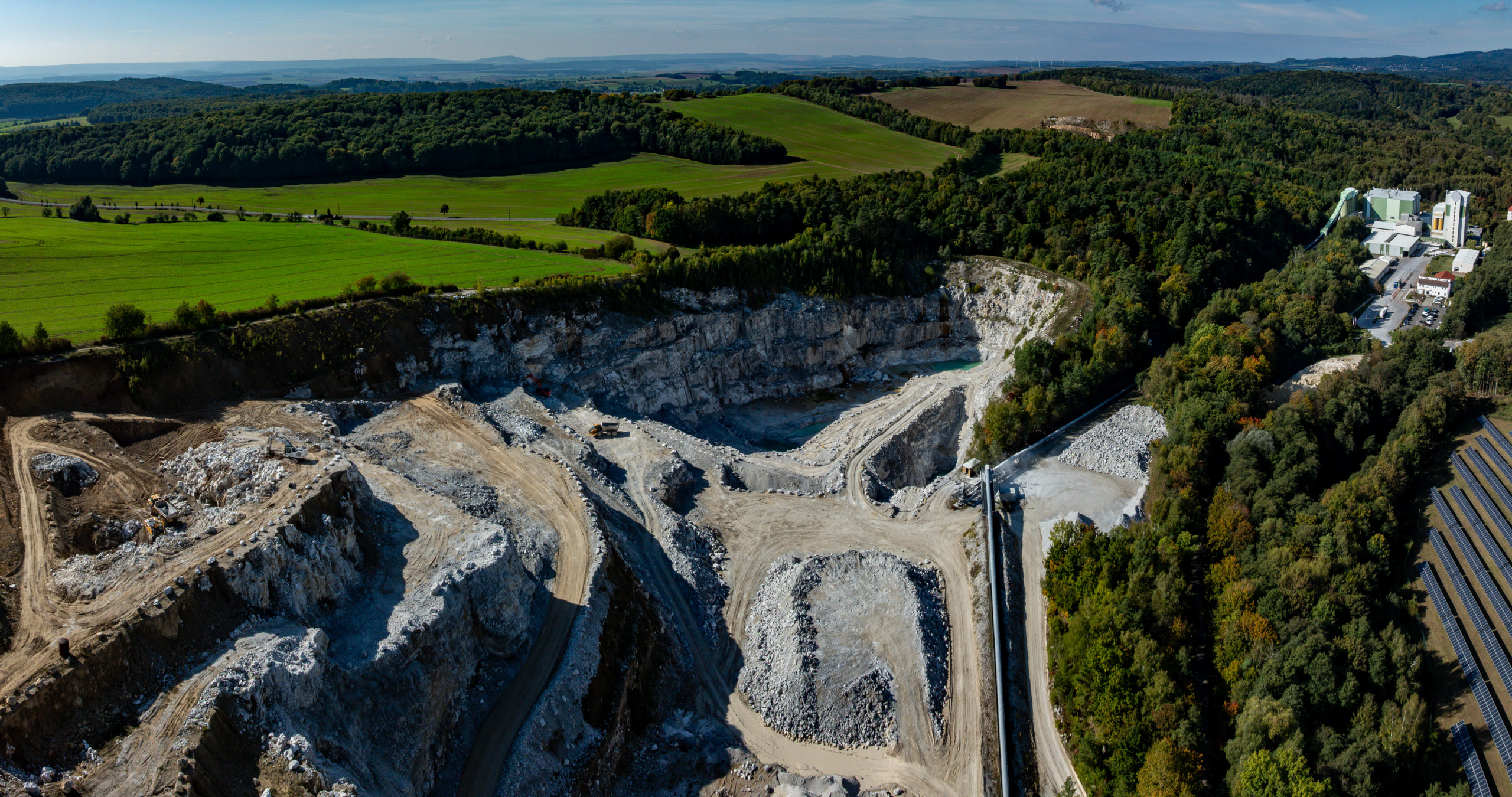
In fact, the extraction of natural gypsum deposits in Germany is controversial – and the coal phase-out is further jeopardising supplies (see info box).
Where does the “white gold” come from?
To date, around half of the gypsum requirement in Germany has been covered by a waste product from coal-fired power stations: so-called FGD gypsum, which is produced in flue gas desulphurisation plants. “With the decision to phase out coal, available quantities of FGD gypsum will gradually dwindle and eventually disappear completely,” according to a 2024 forecast commissioned by the Schleswig-Holstein Ministry of the Environment. “This dwindling availability of raw materials contrasts with growing demand for raw materials in the gypsum processing industry.”
The other half of the gypsum requirement is covered by natural gypsum, which is plentiful in Germany. According to environmental protection organisation BUND, around half of the five million tonnes extracted from the earth each year comes from the southern Harz region. In its “Black Book on Gypsum” (Schwarzbuch Gips), the BUND has documented the extent to which mining is damaging nature in the low mountain range between Thuringia, Saxony-Anhalt and southern Lower Saxony. Gypsum mining has a long tradition here and the mineral is considered “white gold”. However, this mining is transforming Central Europe’s karst landscape – unique with its countless caves and crevices – into a crater landscape, which, according to BUND, means valuable habitats for many rare animal and plant species have been “irretrievably lost”. The Higher Administrative Court in Magdeburg only recently put a stop to further test drilling in a nature reserve back in spring.
But not only environmentalists are critical of gypsum mining. For fear of dust and noise, but above all for their drinking water, citizen-led initiatives are also protesting gypsum mining in other areas of Germany. In Lower Franconia, for example, there is criticism of the plans by building materials giant Knauf to open Germany’s largest gypsum mine.
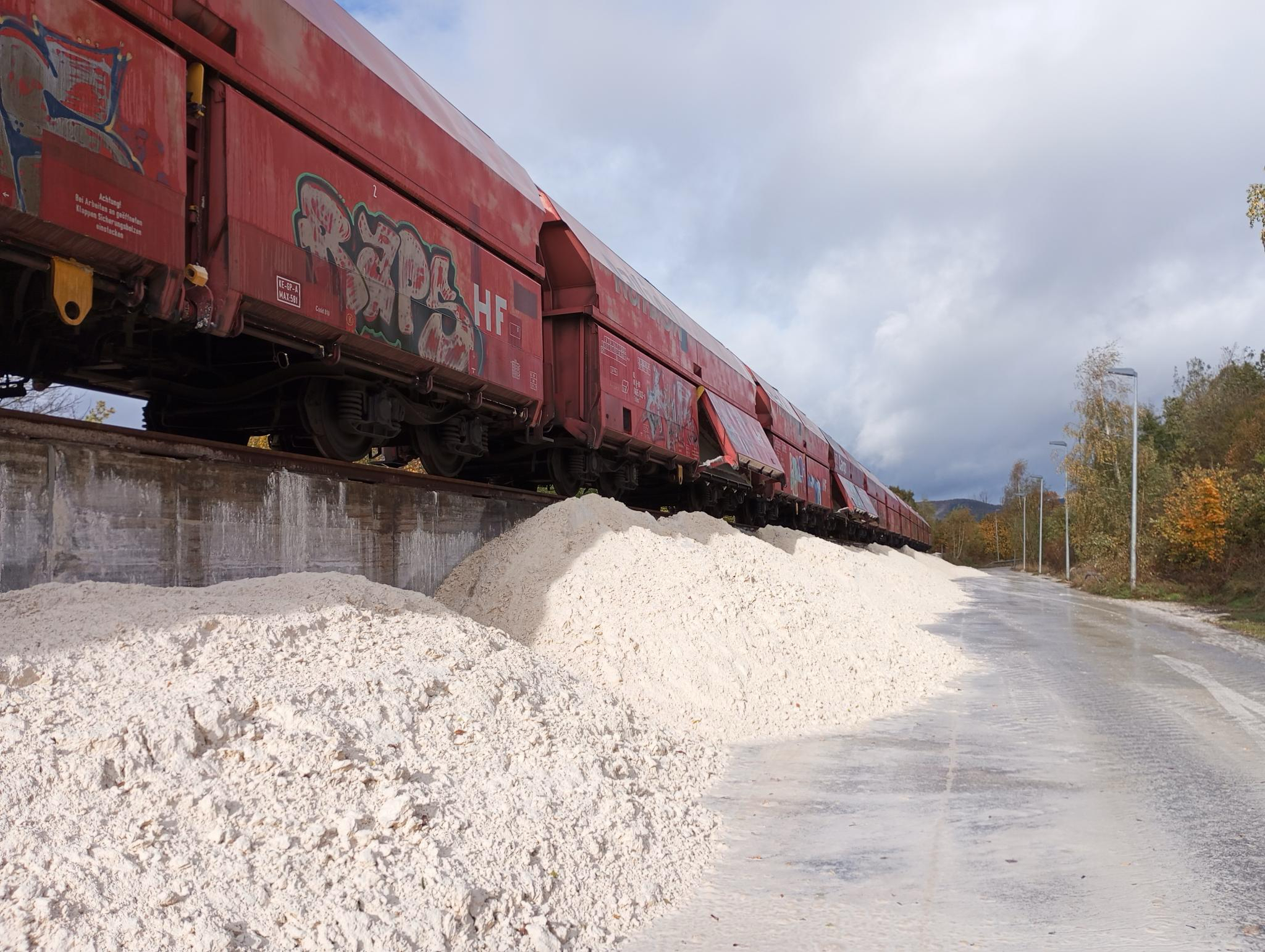
“Infinitely recyclable”
According to the German Federal Environment Agency, around half of the gypsum waste produced in Germany is recyclable. “Gypsum building materials can be recycled repeatedly and thus kept in high-value recycling loops,” emphasises the German Gypsum Industry Association. To date, however, only a small proportion of the waste has been made into new gypsum products (see info box).
How much gypsum actually gets recycled?
Recycling plants for gypsum waste in Germany “have so far been difficult to operate economically,” according to a publication by the Schleswig-Holstein Ministry of the Environment in 2024.
According to the German Gypsum Industry Association, currently only around 13 percent of gypsum waste in Germany is recycled. Other countries are much further ahead: Back in 2017, the German Federal Environment Agency (UBA) reported on established plasterboard recycling systems in the UK, Belgium, the Netherlands, Denmark and Sweden. In these countries, initiatives such as introducing landfill taxes had led to higher recycling rates.
The French plasterboard industry announced in 2025 that over one-third of its products are now made using recycled gypsum. In Denmark, up to 80 percent of gypsum waste is recycled, according to a 2022 report published by the GRÜNE LIGA Network of Ecological Movements and funded by the UBA and the German Federal Ministry for the Environment.
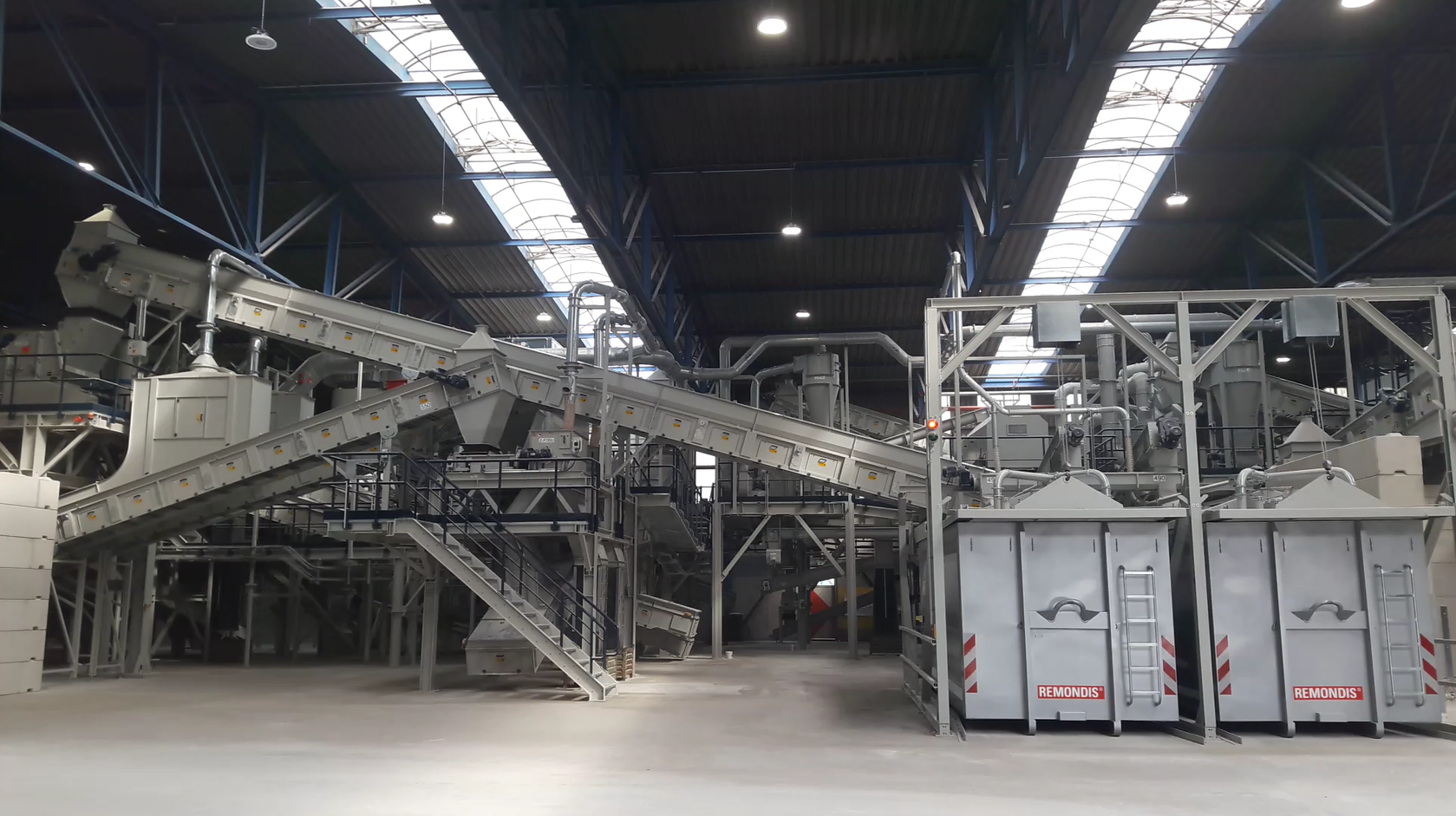
“Most of the gypsum waste that reaches our plant comes from construction companies and municipal recycling centres,” says Manager Christian Salzmann. Acceptance at the Remondis recycling plant, he says, costs up to 70 euros per tonne. Poorly sorted deliveries with lots of impurities are more expensive.
That gypsum waste should be properly separated from other debris on construction sites is a legal requirement. On many construction sites, however, the opposite happens: raw material gypsum is thrown together with other debris – often rendering the whole lot ineligible for recycling (see info box).
Lawless construction sites? Implementation of regulations “inadequate”
“The paramount aim of the German Commercial Waste Ordinance (Gewerbeabfallverordnung – GewAbfV) is to ensure that building materials are collected separately and ideally reused or recycled,” emphasises the Office of Technology Assessment at the German Bundestag (TAB) in a report. On many construction sites, however, the reality appears to be different: “Overall, official monitoring and enforcement of waste legislation on construction sites appears to be inadequate”. Many companies seem to be aware that they apparently rarely need to worry about inspections or even fines, whereby “higher disposal costs for demolition and disposal services for building waste not sorted by type are accepted as inevitable but are ultimately compensated for by the lower labour costs”.
A report by the German Mineral Resources Agency (DERA) and the German Federal Institute for Geosciences and Natural Resources (BGR) comes to a similarly damning conclusion: “Due to a lack of consistent implementation” of legal requirements, separation and collection of construction and demolition waste is “inadequate” and the requirements of the German Waste Management and Product Recycling Act and the German Commercial Waste Ordinance are “not sufficiently adhered to”. Instead, the laws are apparently being “watered down” for one simple reason: it is often cheaper for companies. It is against this backdrop in particular that gypsum waste is disposed of instead of recycled, as “it is permissible to deviate from the waste hierarchy from an economic perspective if, for example, landfilling is significantly cheaper than recycling”.
Companies can decide quite freely whether properly separating their building waste is a worthwhile endeavour: “In economic terms, separate collection or processing is considered legally unreasonable if the additional costs incurred are unreasonably high – but the amount is not defined,” according to the report by the Office of Technology Assessment at the German Bundestag (TAB).
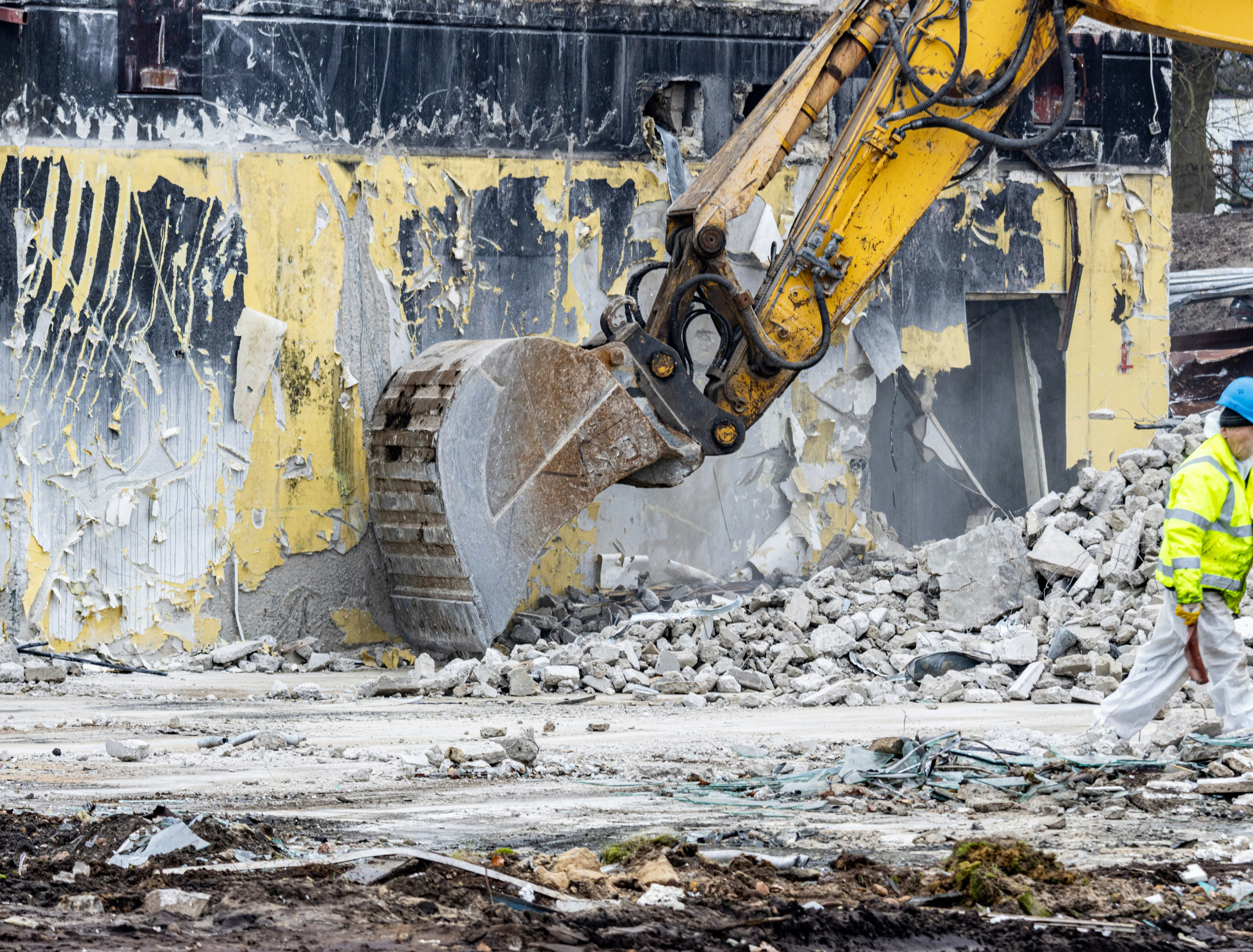
“Our biggest competitor was and remains the Czech Republic”
Remondis Manager Salzmann also criticises the fact his recycling plant is losing out on the raw material – because some building contractors and disposal companies prefer throwing the material away to save costs instead of reutilising it. Salzmann is particularly annoyed by the “cheap disposal” at one place specifically: “Our biggest competitor was and remains the Czech Republic.”
He is referring to the disposal in the uranium sludge ponds in Mydlovary, on which CORRECTIV.Europe has previously reported. Although highly controversial, this was legally permissible under Czech law for a long time because officially, it was deemed a recultivation measure.

Recultivation – that is, the restoration of landscape – involves backfilling old pits left behind by the mining industry. According to the German Federal Environment Agency, however, filling the holes with gypsum waste is “controversial from an ecological standpoint” and is therefore now largely prohibited in Germany (see info box).
Recultivation: plugged pits and white mountains
Recultivation closes the circle, so to speak, of the enormous consumption of resources and high volume of waste generated by the construction industry. The holes bored into the landscape by mining activities in an attempt to satisfy the construction industry’s insatiable hunger for raw materials must ultimately be backfilled. To this end, the open-pit mines where gravel, sand and other building materials were previously extracted are refilled with excavated earth from construction sites as well as debris and other mineral waste.
For a long time, gypsum waste was mainly used in Germany to recultivate potash pit heaps. Potash mining, which involves extraction of rock salts primarily for use in fertiliser production, has given rise to huge white mountains in various regions of central Germany, one of which is referred to by locals as “Monte Kali” or “Kalimanjaro” – wordplays whereby Kali (shorthand for “Kalisalz”, the German word for potash) is used to reference “Monte Carlo” and “Kilimanjaro”.
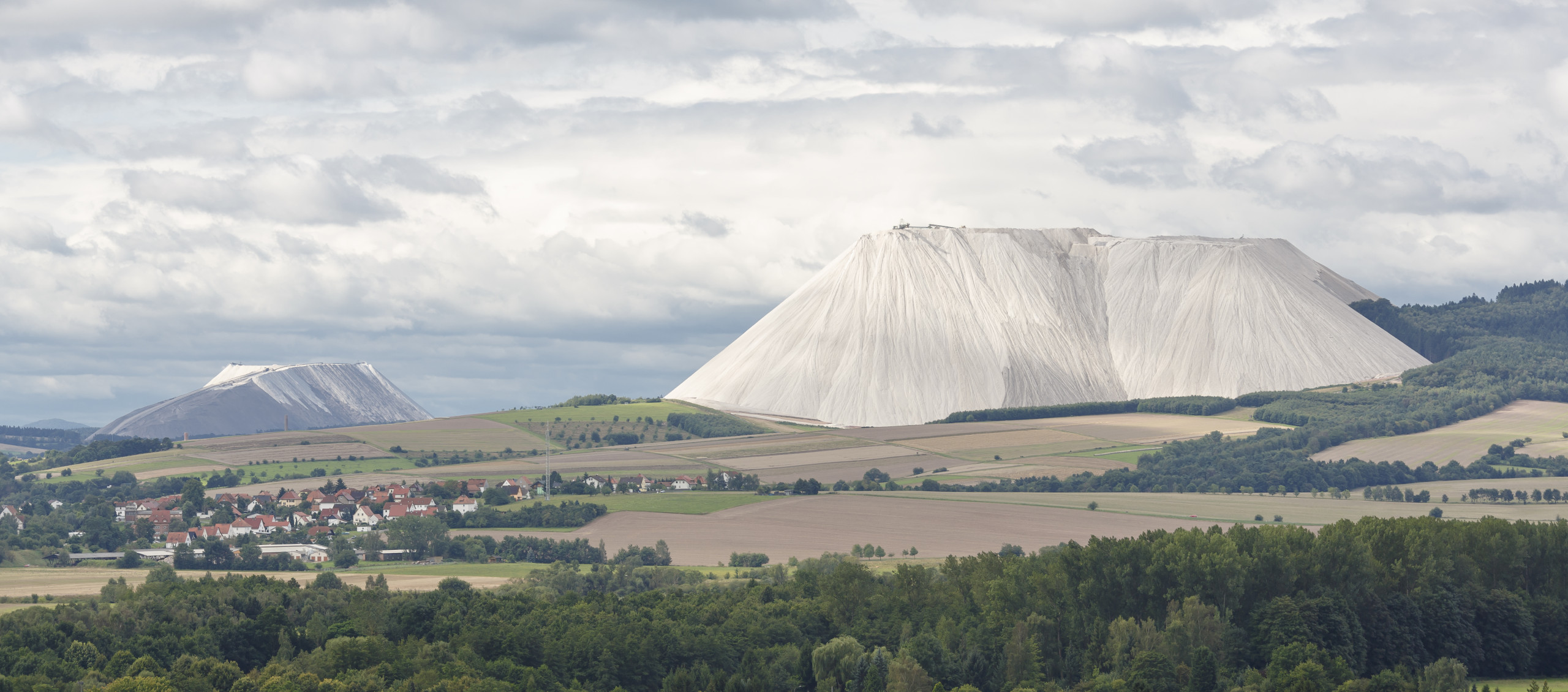
As rain threatens to wash toxins out of the salt mountains, the pit heaps must be covered – and gypsum waste has long been used for this purpose.
Former MEP Dan Jørgensen, who is now Commissioner for Energy and Housing at the EU Commission, criticised this back in 2010, saying this German disposal practice had led to “distortions in competition” and threatened the gypsum recycling industries already established in Denmark and the Netherlands at the time.
The German Federal Environment Agency (UBA) expressed similar criticism in a 2017 report: “High demand for alternative utilisation in mining – controversial though it is from an ecological standpoint – means high-quality recycling of gypsum-based building waste has not developed as desired in recent years.”
Meanwhile, recultivation of potash pit heaps in Thuringia and Hesse is “no longer permitted”, according to the UBA. In other federal states, too, gypsum waste may no longer be used for recultivation of mining pits. Authorities in Bavaria, for example, state that gypsum waste is “fundamentally not a permissible backfill material” there. In Saxony, the material has also no longer been used for recultivation since 2014 due to the “unsuitability of gypsum waste for backfilling open-pit mines”, according to the Saxon Mining Authority.
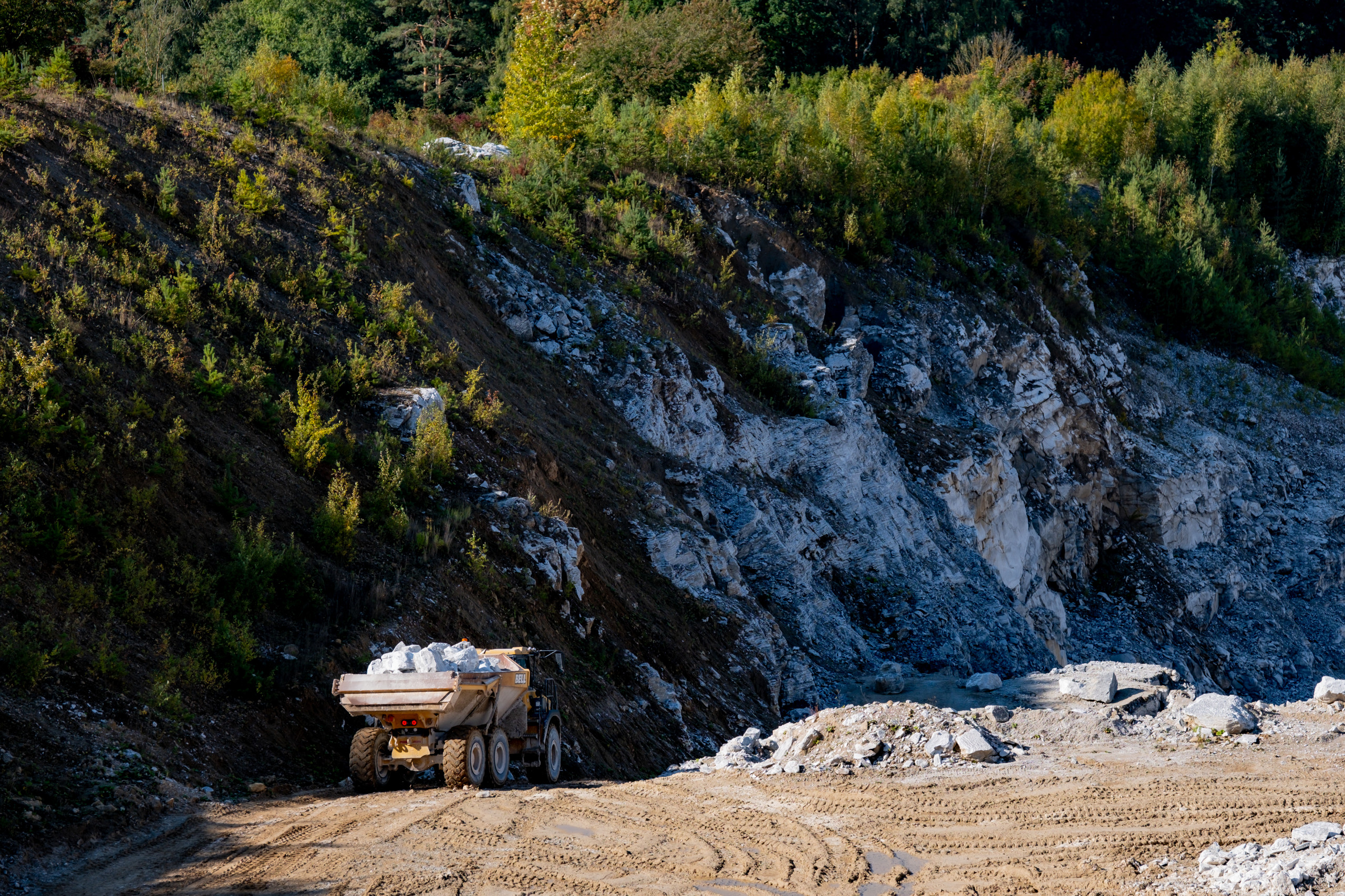
In the meantime, the Czech government is apparently also taking a more critical view of gypsum waste disposal. An amendment to Czech waste legislation means gypsum waste may no longer be used for recultivation purposes there – neither in the uranium sludge ponds in Mydlovary nor other pits. The Czech Ministry of the Environment informed the German Federal Ministry for the Environment about this legislative amendment in summer 2023.
German authorities were informed
In Berlin, it was apparently understood that the change of course in the neighbouring country would have far-reaching consequences for the German waste industry. Indeed, the German Federal Ministry for the Environment forwarded this email containing the news from the Czech Republic to dozens of recipients, including the most important waste industry advocacy groups in Berlin and Brussels, the German Chamber of Commerce and Industry, various law firms, the Association of German Cities (Deutscher Städtetag) and Association of German Districts (Deutscher Landkreistag) – which represent all municipalities and districts at federal level – as well as the waste control authorities of various federal states.
But where does all the gypsum waste from Germany that for years was used to recultivate Czech uranium sludge ponds now end up instead?
In recycling plants – at least, this is the assumption of the German Federal Environment Agency. In response to an enquiry, Germany’s central environmental authority stated: Now that gypsum waste may no longer end up in the Mydlovary uranium sludge ponds, a “notable increase” in gypsum recycling in Germany is to be expected. Apparently, the authority is not aware of “other large-scale ‘utilisation’ or disposal paths in the Czech Republic”.
Waste dealers’ trickery
However, Petr D. apparently also promises such “utilisation” to those customers in Germany whose waste is arranged for transport to the Czech Republic by Bavarian company M. A document in the possession of CORRECTIV.Europe, signed and stamped by Petr D., states that his company “ensures 100% utilisation of waste in accordance with applicable statutory provisions”.
The list of customers includes the two companies with the quarries in which waste from Germany is also suspected to have been dumped. There is no mention of this in the document though. Instead, Petr D. again promises that “all of the waste received will only be utilised and not disposed of”.
He even claims that “efficient management of material flows and cooperation with specialised processing companies” will “increase the proportion of recycled raw materials and promote circular economy by using by-products of the processing as raw materials for new products”. Sounds like recycling – a cheap alternative for companies in Germany?
“Nothing more than a detailed advertising brochure”
“This is exactly how illegal waste disposal works,” says waste expert Berend Wilkens. “Customers are led to believe their waste will be delivered to a recycling plant with comparable standards to Germany. But in reality the stuff just ends up in a pit somewhere.”
Regarding the Czech waste dealer’s document, Wilkens had this to say: “The information isn’t sufficient to reliably indicate whether utilisation of gypsum waste is even authorised in the listed plants. The document should be regarded as nothing more than a detailed advertising brochure”.
An advertising brochure – this, apparently, is exactly how the Czech waste dealer’s letter was construed by M., the Bavarian company which acquires the waste from Germany. Together with Czech permits authorising utilisation of gypsum waste for recultivation purposes in accordance with the former legal situation, company M. apparently presented the letter to its customers in Germany – that is, the companies whose waste is suspected to have ended up in the quarries.
Expert accuses customers of “lack of diligence”
At least, this is what is suggested in an email leaked to us by the insider claiming to have exported gypsum waste to the Czech Republic via company M. CORRECTIV.Europe contacted other companies throughout Germany that are also suspected customers of company M. None of these companies responded to our enquiries.
“Of course, at the very least you also have to accuse the customers of a lack of due diligence,” says expert Berend Wilkens. “The legally prescribed method would be for the waste producers to investigate the utilisation of their waste. Ideally, someone would travel to the Czech Republic and see where the waste is going. And above all whether – and, if so, how – it’s actually being utilised.”
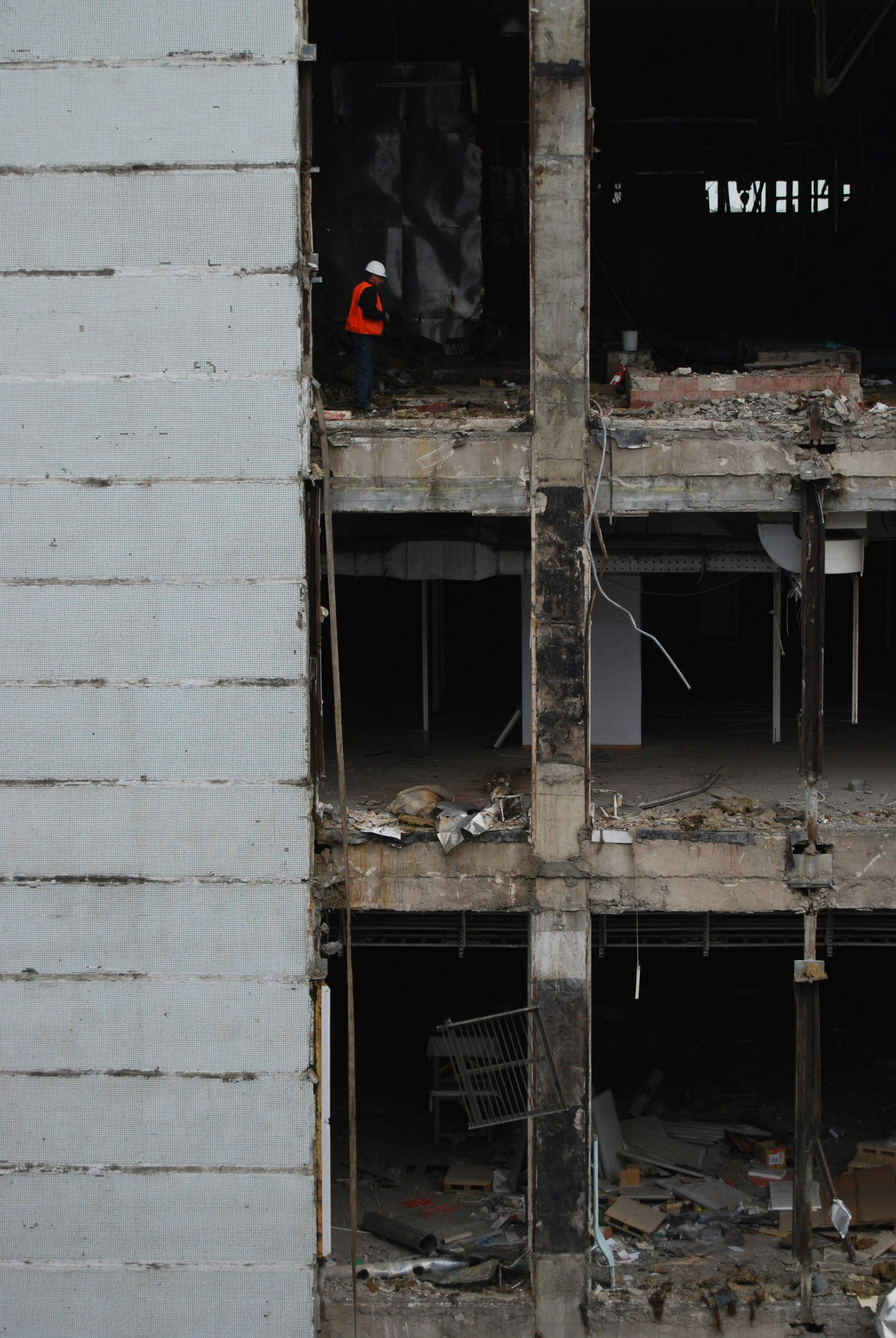
Were customers simply tricked into believing their waste would be utilised in Germany? “Yes” is the response from the authorities in Hesse. The Hessian authorities know of companies that, according to “delivery notes and invoices”, allegedly had their gypsum waste utilised in Germany between 2021 and 2023 – but the “connection to a broker firm and a disposal company in the Czech Republic was not documented until 2024”.
The responsible Regional Council in Kassel does not wish to reveal the name of the export company “for data protection reasons”. However, the authority confirms to us that the waste was sent to the same Czech company to which Petr D. is suspected to have previously delivered masses of waste from Germany. “A small open-pit mine was recognisable on pictures on the internet,” according to the Kassel Regional Council. Moreover: “In the course of the monitoring, a letter from the Czech waste disposal company intending to prove proper material utilisation of the gypsum waste was submitted to the authority”. Hessian officials were apparently not convinced by the letter, however: “The waste producers concerned were advised against further disposal to the company in question.”
Authority sees “no reason to doubt the authorisation situation”
However, the very authority that was supposed to be monitoring company M.’s waste deals was apparently duped by the dubious document. In response to an enquiry from CORRECTIV.Europe, the government of Lower Franconia stated that the company had contacted Bavarian officials by email in May this year with a “request”. The company had asked “whether – taking into consideration the Czech plant permits attached to the email – transports of plasterboard waste and concrete rubble could be carried out pursuant to applicable law”.
Upon request, the government of Lower Franconia confirmed that the email attachment from the broker firm was the same document in which waste dealer Petr D. promised “100% utilisation” of the waste. The authorities were apparently satisfied with this promise and had “no reason to doubt the authorisation situation”.
Insufficient checks in place?
However, when asked, the authority admitted it was not aware of the Czech ban on recultivation with gypsum waste. “It is not possible to judge from here whether an illegality could potentially arise from the current legal situation in the Czech Republic. Company M. was therefore referred by the government of Lower Franconia to the Czech authorities as concerns the question of legality.”
Waste expert Wilkens criticises this: “Normally, the authorities should obtain information from their colleagues in the recipient country. It is unacceptable for an authority to delegate this task to the very company it is supposed to be monitoring.”
According to our investigation, this is how the export business continues to function today – waste is apparently still being dumped.
Credits
Text & Investigation: Marius Münstermann
Editing: Frida Thurm
Data viualisation: Luc Martinon
Fact-checking: Frida Thurm
Design: Mohamed Anwar
Communication: Katharina Roche
This investigation was supported by JournalismFund Europe.

